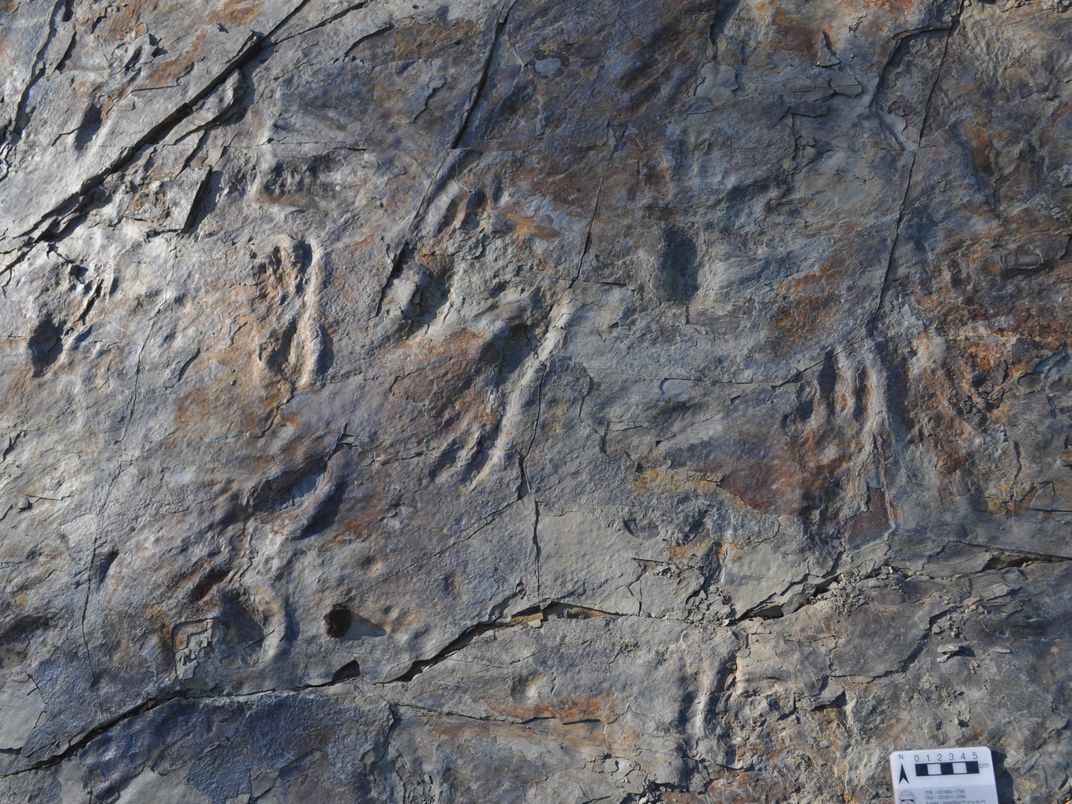Fossil Footprints Suggest Ancient Crocodile Walked on Two Legs
The lumbering crocodylomorph lived during the early Cretaceous period, about 106 million years ago
/https://tf-cmsv2-smithsonianmag-media.s3.amazonaws.com/filer/d4/f0/d4f0fee4-9636-44d3-9bb2-aa7e035bfa30/2020_jun15_crocodile.jpg)
A prehistoric ancestor of the crocodile may have walked on two legs, according to a paper published on June 11 in Scientific Reports.
The new research focuses on large footprints in the Jinju rock formation in South Korea. A 2012 investigation of large, poorly defined footprints suggested that they might have come from a flying reptile called a pterosaur, but clearer footprints discovered recently changed the story. The new footprints capture the shape of the ancient creature’s toes and the texture of its skin, both of which are classically crocodilian. But the footprints had another curious feature: there were only prints from back feet.
To paleontologist Martin Lockley, who specializes in trace fossils at the University of Colorado Denver, the lack of front footprints probably means that the ancient crocodile walked only on its back legs. “We have dozens of these things, and not one sign of a front footprint, so we’re pretty convinced,” Lockley tells Science News.
The tracks are between seven and ten inches long and the animal that left them was probably similar in size to modern crocodiles. It lived during the early Cretaceous period, about 106-million years ago. (The late Cretaceous saw the lifetimes of several dinosaur celebrities like Tyrannosaurus rex, Triceratops and Iguanadon.) The muddy, lake-covered coastal area where the ancient crocodylomorphs lived was a prime location to preserve footprints, Tim Vernimmen writes for National Geographic, and thousands of tracks can be found there today.

“When Martin Lockley visited the site in November 2019, I asked him what he thought of these tracks,” Kyung Soo Kim of Chinju National University of Education in Jinju tells National Geographic. “He immediately suggested that they were of the type known as Batrachopus, a crocodylian. I didn't believe it at that time, because I couldn't imagine a bipedal crocodile. But later, I was convinced by the blunt toes, the toe pads, and the details of the skin.”
The find came as a surprise. Paleontologists have found evidence of bipedal crocodiles before in North Carolina, but that animal lived about 231 million years ago, per Science News. That places it during the Triassic period, or at least 70 million years before the Cretaceous.
“No one knew that large bipedal crocs existed in the early Cretaceous,” Lockley tells New Scientist’s Layal Liverpool.
The new footprints suggest that the previously discovered tracks belong to an ancient crocodile, too. But based on the tracks it left behind, the creature was unlike modern crocodiles in more ways than one. For one thing, the tracks it left behind show that the animal put its feet one in front of the other as it walked, instead of keeping each foot in its own lane like modern crocs, National Geographic reports. And the fossilized footprints show no sign of webbing between the toes, which modern crocs have, per New Scientist.
Stony Brook University paleontologist Pedro Godoy tells New Scientist that while he agrees that the tracks don’t belong to a pterosaur, the unusually large size of the tracks makes him think that more evidence is necessary to link them to an ancient crocodile. But to Emory University paleontologist Anthony Martin, the evidence is convincing.
“[The imprints] really do look like they were made by big crocodilians,” Martin, who was not involved in the new study, tells National Geographic. “Indeed, by ones that were walking on their rear feet and on land. That’s pretty weird. But then again, the Cretaceous was a weird and wondrous time.”